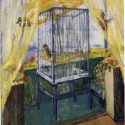Tove Meyer was born in Usserød on Zealand, took her middle school exam in 1928, and at a young age began to paint and write poetry. In 1935, she made her debut with the poetry collection Guds Palet, a title alluding to the image-creating power of the word. She dedicated her debut work to her idol, the poet Helge Rode.
Her early poems bear the stamp of late symbolism, but equally important is the inspiration drawn from Edith Södergran and from the surrealists. The imagery and use of colour give expression to a searching and existentially insistent female first person. Childhood, dreams, and subconsciousness provide important bearings in the poems, and the sea is a recurrent symbol.
Tove Meyer is often compared to her peers, for example to Hulda Lütken and Bodil Bech, however with hindsight, it can be said that her writing reaches beyond the experimental poetry of the 1930s and represents a highly individual and productive alternation between symbolism, surrealism, and modernism. Tove Meyer’s last two poetry collections Havoffer, 1961, and Brudlinier, 1967, led to her poetry enjoying a renaissance among the critics, being recognised by leading modernist poets. Furthermore, her writing has been an important source and inspiration for 1980s writers such as Merete Torp and Søren Ulrik Thomsen, not least owing to its characteristic tension between surrealist and symbolist poetics.
Tove Meyer’s husband, the man of letters Paul Nakskov, published a selection of her poems in 1969 under the characteristic title Tiden og havet. Digte 1935-67. For Tove Meyer personally, the powerful artistic energy and tension present in her works was necessary, yet unendurable, and she ended her life in 1972.


